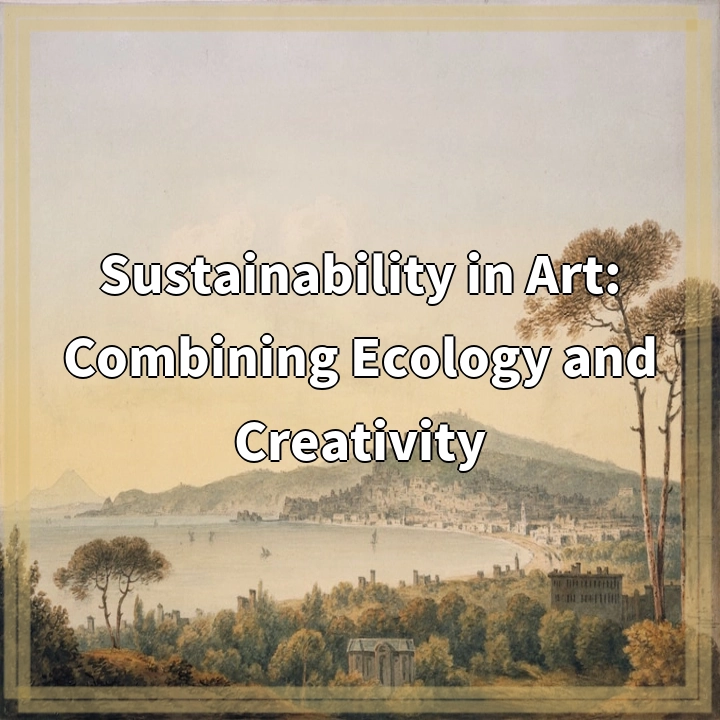
What is Sustainability in Art: Combining Ecology and Creativity?
Sustainability in art refers to the integration of ecological principles and practices within the field of artistic creation and gallery operations. It involves using art as a medium to address environmental concerns, promote sustainable living, and inspire positive change. This approach combines the power of creativity and artistic expression with a deep commitment to environmental stewardship.
Real-World Problems Associated with Sustainability in Art:
1. Waste Generation and Management:
Artistic endeavors often generate a significant amount of waste, including materials, packaging, and leftover supplies. Effective waste management practices, such as recycling and responsible disposal, are essential to minimize the environmental impact of art production and gallery operations.
2. Carbon Footprint:
Transportation of artworks, hosting exhibitions, and operating gallery spaces contribute to the carbon footprint of the art industry. By adopting sustainable transportation methods, energy-efficient operations, and renewable energy sources, the art sector can reduce its environmental footprint and contribute to the fight against climate change.
3. Chemical Pollution:
Artistic practices often involve the use of various chemicals, such as paints, solvents, and fixatives, which can have detrimental effects on the environment if not handled properly. Implementing safer alternatives, minimizing chemical usage, and ensuring proper disposal methods are essential to mitigate chemical pollution in the art sector.
4. Water Conservation:
Water usage is an often overlooked aspect of sustainable art. From cleaning brushes and equipment to maintaining gallery spaces, water conservation efforts can significantly reduce the industry’s water footprint. Reusing water, installing efficient fixtures, and educating artists and staff about responsible water usage are important steps towards achieving sustainability in art.
5. Ethical Sourcing:
The art industry relies heavily on the use of materials, many of which have environmental and ethical implications. Ensuring that materials are ethically sourced, such as using recycled or sustainably produced art supplies, supports the conservation of natural resources and promotes fair trade practices.
6. Lack of Awareness and Education:
A significant challenge lies in creating awareness among artists, gallery owners, and art enthusiasts about the importance of integrating sustainability into art practices. Education and outreach programs can play a vital role in promoting sustainable art and inspiring individuals to adopt environmentally friendly approaches in their creative endeavors.

Solutions for Sustainability in Art: Combining Ecology and Creativity
1. Implementing Effective Waste Management:
To address the issue of waste generation and management, artists and galleries can prioritize the use of recycled or salvaged materials, encourage upcycling and repurposing, and properly sort and recycle waste. Adopting a circular economy approach can minimize waste and promote the reuse of materials within the art community.
2. Reducing Carbon Footprint:
To reduce the carbon footprint of the art industry, efforts can be made to source materials locally, use low-impact transportation methods, and incorporate renewable energy sources. Additionally, galleries can organize virtual exhibitions, reducing the need for physical transportation and lowering their environmental impact.
3. Promoting Safe and Responsible Chemical Usage:
Artists and gallery owners can prioritize the use of non-toxic and eco-friendly art supplies. Implementing proper ventilation systems, safely storing and disposing of hazardous materials, and educating artists on the importance of responsible chemical usage can help mitigate chemical pollution in the art industry.
4. Adopting Water Conservation Measures:
To conserve water, artists and galleries can implement water-saving techniques such as using water-efficient equipment, reusing water for cleaning brushes, and creating awareness about responsible water usage among artists. Installing water-saving fixtures and capturing rainwater for various art-related processes can also contribute to water conservation efforts.
5. Choosing Ethically Sourced Materials:
Artists and galleries can opt for materials that are ethically sourced, such as recycled or sustainably produced art supplies. By supporting fair trade practices, artists can ensure that their creations have minimal environmental and social impact, promoting sustainability within the art industry.
6. Promoting Awareness and Education:
Education and awareness initiatives play a vital role in promoting sustainability in art. Artists, galleries, and organizations can organize workshops, exhibitions, and online resources to educate and engage the art community in sustainable practices. By fostering a culture of sustainability, the art industry can drive positive change and inspire future generations of artists.















